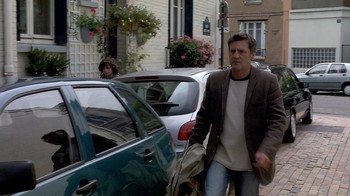 In his “Great Movies” article on Caché, Roger Ebert teases that he found a key to understanding this ever-mysterious movie:
In his “Great Movies” article on Caché, Roger Ebert teases that he found a key to understanding this ever-mysterious movie:
“How is it possible to watch a thriller intently two times and completely miss a smoking gun that’s in full view? Yet I did. Only on my third trip through Michael Haneke’s Caché did I consciously observe a shot which forced me to redefine the film.”
Great! In my single viewing, I was frustrated by the film; I enjoyed its coy, cryptic nature but still don’t get its critical reputation.
Ebert provides the following hint:
“Now I call your attention to the shot I missed the first time through. You will find it on the DVD, centering around 20:39. You tell me what it means. It’s the smoking gun, but did it shoot anybody?”
The trouble is that with different DVD versions in different countries, and with different DVD players, the 20:39 mark might fall on a different shot. I’m guessing that the “smoking gun” in question comes before the dinner party, but beyond that … .
Does he mean this shot, which mimics the tantalizing closing? (Click on the images below for larger versions.)
Or this one, which might only divide days but also shows a blue car in the background?
Or this one, which provides context for the crude drawing on the postcard?
Or this?
There is some discussion on this topic, but none of it is illuminating. Until Ebert himself is less vague, I suspect we’ll all be scratching our heads, and returning to the movie to watch that section ad nauseam.
But perhaps the critic is playing a game here. Caché was released in 2005, and the “Great Movies” series is an opportunity for Ebert to write carefully and at length about an older film without worrying about spoiling its surprises; if you haven’t seen it yet, that’s your own damn fault.
So why is he so evasive? Why doesn’t he describe the specific shot, or at least the one that immediately precedes it, to preclude confusion? Why, with a movie that is hell-bent on (as Ebert says) “confounding our expectations,” won’t he talk about what he sees, and what he thinks it means? A movie as open as Caché won’t be diminished for anybody by one man offering his interpretation.
Perhaps, though, Ebert means to obfuscate. Maybe he wants to see what people come up with, or how many guess correctly. I’m even open to the possibility that there is no “smoking gun” at or near 20 minutes, 39 seconds.
It could just be a trick to get you to watch the movie (again or for the first time), and to watch it closely – and that would make his essay a perfect companion to the movie.

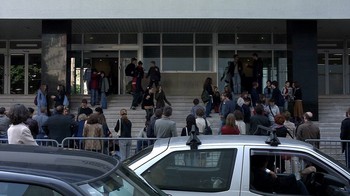
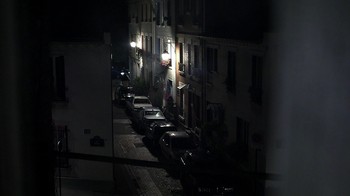
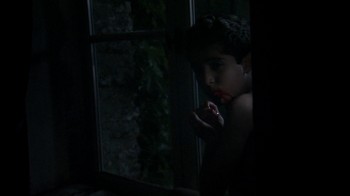
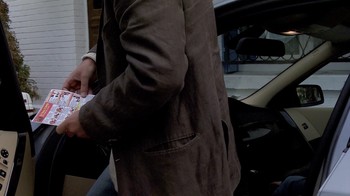

Interesting that this Ebert point should be raised at this moment in time…seeing as though I knew nothing about the movie until only a few days ago. I just bought the movie on a whim and thought I’d have a look at it. (which I have twice, over the last 3 days)
I have to admit that I am totally intrigued by it…and all for just – 5. Now this Ebert thing seems to have taken hold…I’d say that is quite prescient, to say the least.
I honestly think Ebert is referring to the opening shot and the position of Georges car in a subsequent shot…because from looking at the opening scene and the one where George & Pierrot enter the car…the car is parked in the position that the opening shot could’ve been shot from. Obviously this might raise the idea that it could’ve been shot from inside the car or from the roof of the car (depending if Georges car was there at that time)….this begs the question of access/who etc.
Firstly if Ebert is referring to the NTSC version (which is likely in the US) then this 20m 39s is different when viewing the PAL edition…there is a 4% speed up with PAL compared to NTSC. So the equivalent of 20.39 (1239seconds) in the PAL version is approx 19.49 or 19.50 (1189seconds)…which brings the Ebert point to Georges & Pierrot leaving the house to the car. (hopefully I’ve got the timing calculation right re: 4%…but I’m not sure)
Maybe this will be of some help.
Here’s what I think:
michaelmirasol.com/flipcritic/2010/01/caches-smoking-gun.html
Okay, I think I have figured out Ebert’s “Shooting Gun” based on POV, as well as an ALL ENCOMPASSING solution to the mystery (until you all put a dozen holes through it).
The POV in the shot at about the 20 minute mark before the ‘boy with blood’ memory has two characteristics: 1) It is a still shot, implying that is is the objective perspective from someone filming, and 2) It is from a second story level at the street leading right up to George’s front door.
Therefore, Ebert is implying that the person making the tapes was taping from the second floor of George’s house (i.e. Pierrot).
Additionally, even if it a Subjective POV shot, it is still coming from a member of George’s household and aimed directly at the spot from which the opening frames of the movie are being filmed. In other words, Pierrot is looking from his bedroom window at the spot from where they are being filmed and knows where the camera is before his parents tell him of the tapes.
(However, unlike Ebert I am not convinced that POV is the solution, because anyone could have been looking from out of that window, out of pure fear, not neccessarily knowledge. They know they are being filmed from that general direction. And if Ebert means the POV of the person seeing the bleeding boy, it seems to be the POV of someone the height of age six, so it had to be George’s POV from memory and no one else.)
One issue not discussed anywhere of vital imprtance to solving the mystery is that George is a dedicated liar and never reveals what actually happened between him and Majid, although there are two hints: 1) After killing the rooster Majid appears to approach George with violent intent holding up the axe when the scene suddenly ends, and 2) George tells Majid something to the effect of “You were older and stronger than me, I had no choice”. Therefore, what did George do? Was it much more violent than what George finally admits to his wife at the end of the movie? It had to be when he says he was older and stonger and had no choice. George probably beat the living crap out of him and caused him to bleed for days on end, which he has suppressed in his memory as “spontaneous bleeding”. George doesn’t appear to admit to much and is obviously hiding a lot more as implied from the two scenes just mentioned, which is why it is such a painful memory for the Grandmother. It must have been a lot more violent and the family had to send Majid away for his own safety after brushing the family violence under the carpet, and bringing a doctor in to check the boy after waiting for exterior wounds to heal. Kid’s skin wounds heal fast, it could have been a wait of only one or two weeks.
One other issue not mentioned by bloggers which is part of the solution is that Majid may actually be George’s brother conceived through an affair between the Grandmother and the Algerian farmhand. This would explain the desire to adopt him and the guilt caused by exiling him at a young age and the mysterious dissappearance of both parents. This theory is based on the fact that Waleed (Majid’s son) appears to be in touch with the Grandmother and knows about her health. Why if he is he in touch with her does the Grandmother claim to have no memory of him? Something stinks there to high heaven. The only reason they would be in touch is due to a blood or a continuing adoptive relationship.
In any case the story George tells is very very innocent and could not be the cause of so much trauma on Majid’s part and so much guilt on George’s part. His only admission is that he said “I saw him bleeding” and “I told him to kill a rooster”. Hell, on a farm there is a lot of chicken killing going on.
Majid would only kill himself in that gruesome fashion due to very serious childhood trauma, not just being sent away to boarding school.
I don’t think we can say who sent the films, but we can determine who made the films for one good reason: No one had access to Majid’s house to film the confrontation between George and Majid except Majid’s family. Therefore, Either Majid made the tapes, or his son did (independently or in cohoots with Pierrot, it doesn’t matter)
Finally, the second generation seems to know each other based on the closing shot. Majid’s son and Pierrot have some kind of positive relationship. Perhaps Majid’s son approached him at school and made friends with him. Whether they are in league with one another or not is not important.
The point of the movie is that there is a silver lining on the history of violence betwen France and Algeria, led by a new generation that is able to look past racial differences. Pierrot’s hero is none other than Algerian Zinedine Zidane who led France to its last World Cup and has his poster hanging on his bedroom wall. This generation can look past racial differences; Pierrot can have a good relationship with Majid’s son, although we cannot imagine that George’s generation can have an honest relationship with their colonized neighbours.
If anybody is still reading this, there is LITERALLY what to this naive viewer appears to be a smoking gun (as in, a gun with a cigarette coming out the end of it), on the edge of the dinner table beginning at 20:29 or thereabouts.
I assume that’s what Ebert was talking about, which is why he uses the expression ‘smoking gun’ twice.
Cause, you know, he’s having a little fun. I think he’s been having a laugh for a couple years now over this.
Is the ‘gun’ a gag or clue on the director’s part?
I have no effing idea.
It is pointed at Georges, though, indicating that perhaps he is somehow responsible for the videos?
I just saw this movie for the first time this afternoon, and I thought it was brilliant and thought-provoking.
One thing that I have not seen discussed by any reviewer or blogger is the fact that Georges tells Anne that, as a child, he lied about Majid in order to have him removed from the family home. In other words, he lied and told his parents that Majid was coughing blood NOT that Majid was in fact coughing blood. I thought of the association between tuberculosis and coughing blood; sly and spoiled six-year-old Georges could have frightened his parents to think of his contamination by the orphaned Algerian. The second lie had to do with the killing of the rooster. In the horrifying dream sequence, we see Georges menaced by Majid with the axe. If it is true that Georges lied to have Majid removed, then would it not stand to reason that Majid was the cowering victim and Georges was the plotting aggressor? The dreams perpetuate the fabrications that Georges told his parents rather than what actually happened; because Georges is such an unreliable narrator, his audience, including Anne, is left to wonder what else he is not telling.
At the end of the movie, I did catch the meeting between Majid’s son and Pierrot. I think that they probably were co-conspirators. Pierrot, I believe, was motivated by his sense of invisibility. Much of the dialogue regarding him is centered around one question, “Where’s Pierrot?” Perhaps Pierrot was gone missing, trying to shake his parents out of their false and comfortable existence that seems to approach any unpleasantness from angles instead of head-on. The swimming sequences seem to be an extended metaphor for Pierrot’s attempt to wash away the sins of his father.
I just watched the film today for the first time. Amazing experience, that’s for sure, especially reading about Roger Ebert’s finding and all the theories that people came up with to solve the mystery.
Of all the comments here, I think theseboots’ came closest to what I understood. I think the dream scenes were actual flashbacks (the first time the bloodied-mouth kid is seen, during the night facade tape, Georges was not sleeping) rather than depictions of Georges’ supposed lies.
I think Majid actually bullied Georges’, out of anger after the death of his parents by the hands of the French – Georges being his scapegoat. If the dream scenes are to be interpreted as literal memories, than they directly contradict Georges stating these events were lies, COMPLETELY turning our interpretation of the plot (Georges as guilty) upside down (Majid as guilty – ultimately commiting suicide when ghosts of his past return to torture him).
I honestly think that is the conclusion Roger Ebert came to, the smoking gun being the flashback of a young Majid actually coughing blood.
As for the tapes, I agree that Waleed conspiring with Pierrot make some sense, even tho Waleed denied and Pierrot receives that card and seem oblivious to the meaning. At any rate, as Haneke (the director) seem to reinforce in interviews, it doesn’t matter WHO sent the tapes; the point of the movie is not that.
I’m glad I found this discussion. I just saw this film for the first time and am intrigued to figure it out. Toward the end of the movie, when Anne takes the last tape out of the machine and hands it to Georges, isn’t there something pasted on the cover of the tape? Is it part of the flyer that was on the car? Is this the “smoking gun” Ebert was talking about?
It’s the camera movement, folks! Don’t you notice that in the beginning of the shot, it looks exactly like one of the tape recordings? It’s the exact same angle, when all of a sudden, the camera starts moving!
You’ll read about the importance of camera movements in Ebert’s review a lot, and that’s actually the most obvious thing! The flyer? Of no significance. The position of the car? Seen earlier. Majid coughing up blood? Seen more often, a too obvious (and stupid) “smoking gun”.
But the moving camera, that’s of importance! It is the “surveillance angle” and then starts moving. It’s obviously a “feature film shot”, no surveillance one. Why? Because Pierrot is in the frame. He’s never seen on the tapes. Think about the movement…
Brillant observation!
At that time frame, Majid as a young boy is seen standing by a window on the estate coughing up blood. Georges thought he had framed the boy, when Majid actually did have TB. Elsewhere in the film, Georges states he told his parents he had seen Majid cough blood, but they didn’t believe him. I think little Georges actually witnessed a coughing of blood event. When not believed, he resorted to tricks to get rid of Majid. His guilt over actual tricks may have led him to mistemember what he had honestly seen. The threat of TB wud have been a frightening specter to a young child.